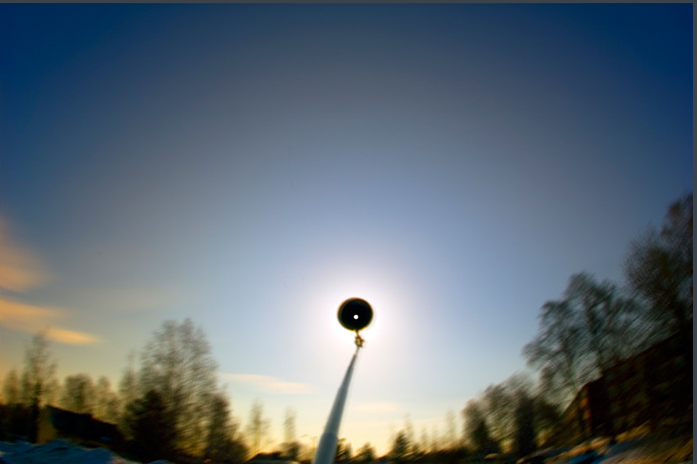Tropospheric Bishop
Tropospheric Bishop: Exploring the Phenomenon of the Bishop's Ring
The atmospheric optics phenomenon known as the Bishop's Ring is a captivating display of nature's wonders. Similar to a corona, this diffraction pattern in the sky is created by the scattering of light from minuscule particles. While a typical corona is produced by cloud water droplets, the Bishop's Ring originates from even smaller objects, such as stratospheric sulfate and dust particles. These particles are often remnants of massive volcanic eruptions that scatter sunlight and contribute to breathtaking sunsets and twilights.
The Bishop's Ring, larger than a 22° halo, presents itself as a distinctive reddish ring in the sky. However, what sets this particular ring apart is its formation in the troposphere, specifically within nascent altocumulus clouds. This unique occurrence was observed by Marko Riikonen in Tampere, Finland, who captured its beauty through a series of photographs.
To emphasize the delicate details and contrasts of the ring, Riikonen employed a technique called image stacking. By combining multiple images centered on the sun, he accentuated the softness of the ring's appearance. In contrast, a single exposure image showcased the ring's characteristics with equal brilliance.
The formation of the Bishop's Ring in the troposphere is a result of supercooled water droplets with incredibly small diameters, measuring around 0.5 microns or smaller. These droplets exist at the lower end of cloud sizes, contributing to the rarity of this phenomenon. As the tropospheric cloud thinned during Riikonen's observation, the red zone gradually vanished, leaving behind a mesmerizing blue ring that persisted.
This extraordinary atmospheric optics event serves as a reminder of the interconnectedness of various atmospheric layers and their influence on optical phenomena. The presence of stratospheric sulfate and dust particles in the troposphere highlights the complex dynamics of our atmosphere. Additionally, the Bishop's Ring showcases the impact of volcanic eruptions on atmospheric conditions and the visual spectacle they can create.
As we marvel at the beauty of the Bishop's Ring, it is essential to recognize the role that atmospheric optics plays in our understanding of the natural world. By studying and documenting these phenomena, scientists gain insights into the intricate processes occurring within our atmosphere. Furthermore, these captivating displays serve as a reminder of the ever-changing nature of our environment and the continuous interplay between light and particles.
In conclusion, the Bishop's Ring presents a captivating example of atmospheric optics that showcases the unique interplay between light and particles in the troposphere. This phenomenon, formed by minuscule stratospheric sulfate and dust particles, highlights the aftermath of volcanic eruptions and their influence on optical displays in the sky. Through the observations of dedicated individuals like Marko Riikonen, we gain a deeper appreciation for the complexity and beauty of our atmosphere. The Bishop's Ring serves as a reminder of the interconnectedness of different atmospheric layers and the awe-inspiring wonders that can be found right above our heads.

Tropospheric Bishop's Ring
Imaged at Tampere, Finland on the morning of 31st March by Marko Riikonen (more ring images, site).
Images ©Marko Riikonen.

The upper image is not out of focus! It is a stack of several images centered on the sun to accentuate the soft details and contrasts of the ring. The lower image is a single exposure.
"I went out to look for halos. But upon looking at the mirror .to reveal faint and subtle sky phenomena the Bishop's ring caught my attention. It occurred in some cloud that seemed like it could develop to altocumulus (Ac). Went inside to get camera and took about 20 photos to stack. It was not as good .as previously. but still OK, the cloud was thinning. As the cloud thinned even more the red zone disappeared leaving only blue, which stayed."
A Bishop�s ring is essentially a huge corona, a diffraction pattern in the sky produced from light scattering by very small particles. This one is larger than a 22� halo.
The cloud water droplets that produce an ordinary corona are typically 10 to 30 micron across. The larger Bishop�s ring comes from much smaller objects and most often they are stratospheric sulfate and dust particles, the sometimes globally distributed aftermath of large explosive volcanic eruptions. The same particles give glorious sunsets and twilights.
This ring is different. Marko is sure that it was formed in the troposphere, in nascent altocumulus. The reddish ring is ~30� in radius and an IRIS calculation indicates that the supercooled water droplets were only ~0.5 micron or smaller diameter, at the very lowest end of the sizes in clouds.
Note: this article has been automatically converted from the old site and may not appear as intended. You can find the original article here.
Reference Atmospheric Optics
If you use any of the definitions, information, or data presented on Atmospheric Optics, please copy the link or reference below to properly credit us as the reference source. Thank you!
-
<a href="https://atoptics.co.uk/blog/tropospheric-bishop/">Tropospheric Bishop</a>
-
"Tropospheric Bishop". Atmospheric Optics. Accessed on April 19, 2024. https://atoptics.co.uk/blog/tropospheric-bishop/.
-
"Tropospheric Bishop". Atmospheric Optics, https://atoptics.co.uk/blog/tropospheric-bishop/. Accessed 19 April, 2024
-
Tropospheric Bishop. Atmospheric Optics. Retrieved from https://atoptics.co.uk/blog/tropospheric-bishop/.